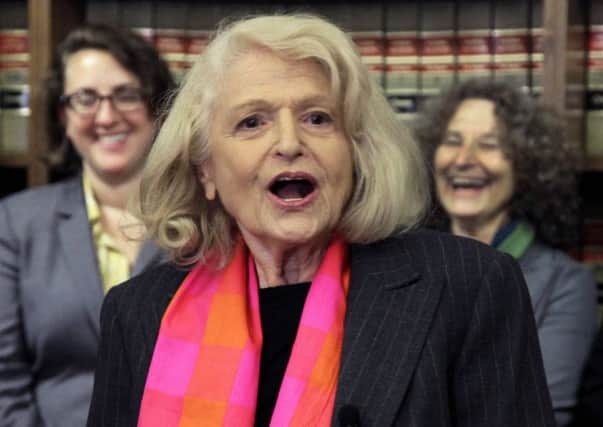Obituary: Edith Windsor, gay rights activist


Windsor died aged 88 in New York, said her lawyer, Roberta Kaplan. The cause of death was not given, but Windsor had struggled with heart issues for years.
“The world lost a tiny but tough-as-nails fighter for freedom, justice and equality,” said her spouse, Judith Kasen-Windsor. They married last year.
Advertisement
Hide AdAdvertisement
Hide AdWindsor became a gay rights pioneer after her first spouse, Thea Spyer, died in 2009. The women had married legally in Canada in 2007 after spending more than 40 years together.
At 81, Windsor sued the US federal government, saying its definition of marriage as a relationship between a man and a woman prevented her from getting a marital deduction on Spyer’s estate. That meant she faced a huge tax bill that heterosexual couples would not have.
“She refused to accept the injustice levelled at the love of her life,” US House Democratic leader Nancy Pelosi said.
The US Supreme Court ruled 5-4 in June 2013 that the provision in the federal Defense of Marriage Act was unconstitutional, and that legally married same-sex couples are entitled to the same federal benefits heterosexual couples receive.
The opinion gave the nation’s legally married gay couples equal federal footing with all other married Americans and marked a key moment of encouragement for gay marriage supporters confronting the nationwide patchwork of laws that, at the time, outlawed such unions in roughly three dozen states.
It also affronted conservatives who hewed to defining marriage as between a man and a woman. Then-Supreme Court Justice Antonin Scalia predicted the ruling would be used to upend state restrictions on marriage and warned: “The only thing that will ‘confine’ the court’s holding is its sense of what it can get away with.”
Ultimately, the opinion in Windsor’s case became the basis for a wave of federal court rulings that struck down state marriage bans and led to a 2015 Supreme Court ruling giving same-sex couples the right to marry from coast to coast.
“She will go down in the history books as a true American hero,” Ms Kaplan said. Anthony Romero, executive director of the American Civil Liberties Union, called Windsor “one of this country’s great civil rights pioneers”.
Advertisement
Hide AdAdvertisement
Hide Ad“One simply cannot write the history of the gay rights movement without reserving immense credit and gratitude for Edie Windsor,” he said.
New York governor Andrew Cuomo, a Democrat, said he was heartbroken by the death of a woman who “embodied the New York spirit, taking it upon herself to tear down barriers for others.”
Windsor said she was “honoured,” ‘’humbled” and “overjoyed” when the decision came down. According to The New Yorker magazine, she called a friend and said, “Please get married right away!”
She was a finalist for Time magazine’s Person of the Year in 2013 (Pope Francis ultimately got the honour) and was invited the next year to a state dinner at the White House, honouring then-French president Francois Hollande.
Windsor was born in Philadelphia and moved to Manhattan in the early 1950s after a brief marriage to a man that ended after she told him she was gay.
She received a master’s degree in mathematics from New York University in 1957 and went to work for IBM in senior technical and management positions.
Spyer came into her life in 1963, and they became a couple two years later. In court documents, Windsor said she told Spyer, “’If it still feels this goofy joyous, I’d like us to spend the rest of our lives together.’ And we did.”
Concerned that an engagement ring would bring unwanted attention to Windsor’s sexual orientation from colleagues at IBM, Spyer gave Windsor a diamond brooch.
Advertisement
Hide AdAdvertisement
Hide Ad“Our choice not to wear traditional engagement rings was just one of many ways in which Thea and I had to mould our lives to make our relationship invisible,” Windsor said in court documents.
“We both faced pressures not only in the workplace and in society at large, but also from family and friends,” she added. “Like countless other same-sex couples, we engaged in a constant struggle to balance our love for one another and our desire to live openly and with dignity, on the one hand, with our fear of disapproval and discrimination from others on the other.”
Spyer was diagnosed with multiple sclerosis in 1977, and her physical condition deteriorated over the decades. The women married in Canada when they realised they might not be living when New York state legalised same-sex marriage, which it did in 2011.
Windsor also had health problems for years. After Spyer’s death in 2009, she had an attack of stress cardiomyopathy, also known as broken heart syndrome, that was so bad that her heart stopped.
Deepthi Hajela & Jennifer Peltz